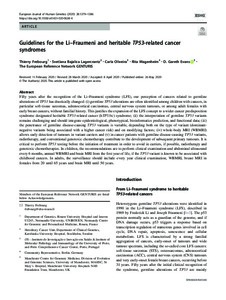Guidelines for the Li-Fraumeni and heritable TP53-related cancer syndromes
Frebourg Thierry; Lagercrantz Svetlana Bajalica; Oliveira Carla; Magenheim Rita; Evans D Gareth; European Reference Network GENTURIS
Guidelines for the Li-Fraumeni and heritable TP53-related cancer syndromes
Frebourg Thierry
Lagercrantz Svetlana Bajalica
Oliveira Carla
Magenheim Rita
Evans D Gareth
European Reference Network GENTURIS
NATURE PUBLISHING GROUP
Julkaisun pysyvä osoite on:
https://urn.fi/URN:NBN:fi-fe2021042822732
https://urn.fi/URN:NBN:fi-fe2021042822732
Tiivistelmä
Fifty years after the recognition of the Li-Fraumeni syndrome (LFS), our perception of cancers related to germline alterations of TP53 has drastically changed: (i) germline TP53 alterations are often identified among children with cancers, in particular soft-tissue sarcomas, adrenocortical carcinomas, central nervous system tumours, or among adult females with early breast cancers, without familial history. This justifies the expansion of the LFS concept to a wider cancer predisposition syndrome designated heritable TP53-related cancer (hTP53rc) syndrome; (ii) the interpretation of germline TP53 variants remains challenging and should integrate epidemiological, phenotypical, bioinformatics prediction, and functional data; (iii) the penetrance of germline disease-causing TP53 variants is variable, depending both on the type of variant (dominant-negative variants being associated with a higher cancer risk) and on modifying factors; (iv) whole-body MRI (WBMRI) allows early detection of tumours in variant carriers and (v) in cancer patients with germline disease-causing TP53 variants, radiotherapy, and conventional genotoxic chemotherapy contribute to the development of subsequent primary tumours. It is critical to perform TP53 testing before the initiation of treatment in order to avoid in carriers, if possible, radiotherapy and genotoxic chemotherapies. In children, the recommendations are to perform clinical examination and abdominal ultrasound every 6 months, annual WBMRI and brain MRI from the first year of life, if the TP53 variant is known to be associated with childhood cancers. In adults, the surveillance should include every year clinical examination, WBMRI, breast MRI in females from 20 until 65 years and brain MRI until 50 years.
Kokoelmat
- Rinnakkaistallenteet [27094]
